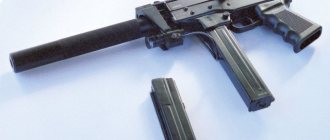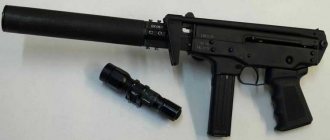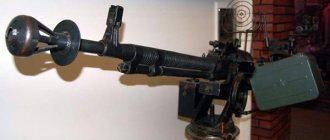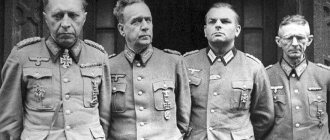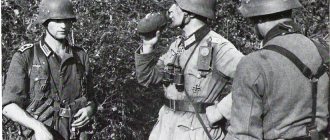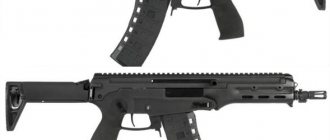Many modern experts in the field of short-barreled weapons believe that the PP-91 “Kedr” submachine gun is a rather outdated weapon, and its tactical and technical characteristics, which were relevant in the early 90s, are now quite far from the standard of rate of fire, accuracy and sighting range. Let's try to understand how suitable the PP-91 "Kedr" is as a close-combat weapon for solving modern operational combat missions. PP-91 "Kedr" was developed on the basis of PP-71. It was this model that was chosen by the designer Dragunov, who developed the PP-91 in the early 90s. Some time after the adoption of the Kedr, the Kedr service carbine came into service, which was used in private security companies.
The history of the appearance of PP-91 “Kedr”
After World War II, most countries abandoned the production of submachine guns, as they turned out to be low-power and ineffective on the battlefield compared to machine guns (or automatic rifles, as they are commonly called abroad). A couple of decades later, when it became clear that in peaceful conditions machine guns were too bulky and their power was excessive for operational combat missions, many countries again began developing small-sized submachine guns.
In the USSR, the development of small-sized PCBs began in earnest in the early 70s. A special set of tasks was created to create small-sized submachine guns of 9x18 PM caliber. This set of tasks was called “Bouquet”. During these years, all the created models that were submitted for testing turned out to be unfinished. As a result of the tests, none of them was put into service and the development of small-sized SMGs was “forgotten” for 20 years.
In the 90s, when the Ministry of Internal Affairs of the Russian Federation became interested in the creation of PP, designers again returned to the development of submachine guns, remembering the “Bouquet” complex. The new PP was supposed to be an intermediate link between the Makarov pistol and the AKS-74U.
Particular attention of the developers was attracted by the PP-71 model, which was developed by Evgeny Dragunov. Wanting to improve his father’s model, his eldest son began to develop a new pistol at Izhmekh. After modifications, the new model was named PP-91 “Kedr” in honor of Evgeniy Dragunov. Immediately after its development and adoption, the new submachine gun became very popular among special forces soldiers of the Ministry of Internal Affairs.
Together with the Kedr, the Klin modification was created, which was created according to a design scheme that was identical to the Kedr. In 1994, production of PP-91 was moved to the Zlatoust Machine-Building Plant. Currently, the Kedr is in service with units of the Ministry of Internal Affairs and various special forces.
Modifications
During its short existence, the PP-91 acquired several different modifications. Basically, these are changes to feed various types of ammunition, but there are also more thorough options. Minor modified samples include PP-91-01 (with a built-in silencer) and PP-91-02 (a self-loading model that did not go into production).
A little more interesting was the sample using the 9*18 PMM cartridge. It was called PP-9 “Wedge”. It was produced for the Ministry of Internal Affairs of the Russian Federation in the early 2000s. In addition to improved ammunition, which gives a higher ballistics rating, changes affected the bolt (its mass increased) and helical grooves appeared inside the chamber.
Although the 9*18 PM cartridge is widespread and warehouses are simply filled with it, it did not satisfy with its quality, which negatively affected the effectiveness of the battle. The designers decided to begin manufacturing the PP-919 “Kedr-2” for 9*19 “Parabellum” ammunition. This option was submitted to the Tax Police.
Son of Dragunov, Andrey and V.M. Kalashnikov also designed their own modification of the PP-91, under the name PP-27 “Klin-2”. In it, the magazine shaft is moved to the handle in the manner of Israeli Uzis.
Unfortunately, it did not go into series. Only two versions were manufactured: chambered for 9*18 PMM and 7.62*25 TT.
For official use by collectors and employees of private security organizations, a special modification has been developed - PKSK-10. Its main difference is the use of a weakened and weakly ricocheting 9*17 Kurtz warhead. The changes also affected the internal mechanisms - there is no automatic firing. The possibility of installing a flame arrester is not provided. The bright part is the receiver cover painted white.
This mark allows police officers to identify the weapon as non-military. The magazine holds only 10 rounds.
Models KMO-9 “Korsak” 9*21 mm and KSO-9 “Krechet” 9*19 mm are produced as training and sports variations. Both products had an elongated barrel, were self-loading, and were equipped with magazines that only held 10 rounds.
PST “Corporal” is a self-loading version, chambered for the 10*23 mm T cartridge, traumatic. It is in service with security organizations. Ten-round clip.
PPA-X “Tirex” is a replica as close as possible to the original PP-91. The operating principle is based on the use of pneumatics. Shoots 4mm pellets. Can fire in bursts. It is not a military weapon.
Operation of PP-91 and its performance characteristics
The performance characteristics of the PP-91 are as follows:
- Caliber PP “Kedr” – 9 mm;
- The cartridges used for shooting are 9x18 PM;
- The number of rounds in the magazine is 20 or 30, depending on the magazine, which come in both standard and increased capacity. The enlarged magazine comes included with the standard one;
- The weight of the weapon without cartridges in the magazine is 1.54 kg;
- PP barrel length – 120 mm;
- The overall length of the PP varies depending on the condition of the stock. If it is folded, then 305 mm, if unfolded, then 539 mm;
- The maximum rate of fire of the SMG is 800/850 rounds per minute;
- The initial bullet speed is 310 m/s;
- The Kedr can fire aimed fire at a distance of up to 50 meters;
- The best effect is achieved when shooting at a distance of up to 25 meters.
Despite the fact that the PP-91 is an automatic submachine gun, it is recommended to fire single shots or short bursts of 2-4 shots in combat, otherwise you can quickly empty the magazine and be left without a weapon. The most optimal rate of fire is considered to be 40-50 rounds per minute, that is, ammunition plus 1-2 spare magazines.
The front sight of the PP-91 “Kedr” is adjustable, and the rear sight with a slot can be replaced with a diopter one. When replacing the rear sight, aiming becomes easier, since the weapon can be aimed at the target much faster. At a distance of 25 meters, 1-2 bullets are enough to neutralize the target. In order to fire a shot from the Kedr submachine gun, you must first select the fire mode, then release the shutter, and then press the trigger.
If the PP-91 is switched to automatic fire mode, then shots will be fired (with the trigger pressed) until the cartridges run out or the trigger is released. If you shoot in single-fire mode, then for each shot you need to press the trigger separately. "Cedar" is available in two modifications:
- Standard PP-91 “Kedr”;
- "Kedr-B", which has an integrated muffler. This modification is made only on special orders.
Specifications
The PP-91 “Kedr” submachine gun is a classic PP operating on the blowback principle.
The shot occurs as follows. After chambering the cartridge, the bolt of the submachine gun is in the extreme forward position. After pressing the trigger, the trigger, interacting through a system of levers and springs, releases the trigger, which hits the firing pin, transmitting the force to break the cartridge primer.
After the shot, the recoil energy pushes the bolt back, the massive body of the bolt rolls back to the rearmost point, grabbing the cartridge case flange with the ejector tooth along the way. It hits the reflector and flies out to the side, leaving the receiver.
The bolt, compressing the return spring, stops by cocking the trigger.
After stopping, under the action of a spring, it begins to move forward, capturing the next cartridge from the neck of the magazine and sending it into the barrel. The cycle continues.
The machine gun has a manual shot safety and an automatic fire mode. The magazine is box-shaped, metal, the cartridges are staggered, the outlet is in one row. The magazine capacity is determined based on the task. The PP-91 comes standard with 20- and 30-round magazines.
Regarding ergonomics. The PP-91, thanks to its size, literally has everything at hand. On the right, near the trigger, there is a flag-type fuse. When activated, part of it protrudes beyond the boundaries and the operative can always understand by touch that the weapon is blocked.
Nearby is a lever that releases the magazine.
A folding stock is attached to the back of the receiver. If necessary, it can be easily deployed. To do this, just pull it up and back, the sights become accessible; diopter rear sight and front sight. When folded, aiming is carried out using open-type means.
A disadvantage of the PP can be considered its excessive simplification, which creates some problems when the weapon becomes dirty. Cartridges often get stuck during intense shooting. There are problems with automatic magazines of medium production series. The mild steel spring “sits” very quickly.
The Kedr submachine gun also has positive aspects. First of all, it is compact in size. About half a meter when unfolded. At the same time, it has mild recoil - due to the stock and the 9*18 PM cartridge, which allows it to achieve high accuracy at a working distance - up to 100 meters.
Design and preparation for use of PP-91 “Kedr”
PP-91 “Kedr” consists of the following parts:
- The barrel together with the receiver, which has a lid;
- Sights consisting of a front sight and rear sight, which can be either regular with a slot or diopter;
- The handle and butt, which is equipped with a folding mechanism;
- Trigger mechanism;
- Fire mode switch fuse;
- Modification "Kedr-B", which has a muffler and an expansion chamber with a mesh roll.
The Kedr submachine gun is supplied in the following kit:
- The submachine gun itself;
- Two magazines included for 20 and 30 rounds;
- Rubbing;
- Punch;
- Special key for front sight adjustments;
- Oil can with gun oil;
- Transport bag and product passport.
To ensure that the weapon does not fail in unforeseen situations, it is recommended to first prepare it for firing:
- To do this, the submachine gun should be disassembled and all its parts should be visually inspected for damage;
- Next, you need to remove excess weapon lubricant from all parts;
- Each cartridge that is loaded into a magazine should be carefully inspected for visual damage;
- The barrel bore must be inspected for the presence of moisture, and if present, the barrel must be thoroughly cleaned.
Do not forget that if the weapon is used in sub-zero temperatures, then before placing the magazine, you need to jerk the bolt several times.
Specifications
The PP-91 “Kedr” submachine gun is a classic PP operating on the blowback principle.
The shot occurs as follows. After chambering the cartridge, the bolt of the submachine gun is in the extreme forward position. After pressing the trigger, the trigger, interacting through a system of levers and springs, releases the trigger, which hits the firing pin, transmitting the force to break the cartridge primer.
After the shot, the recoil energy pushes the bolt back, the massive body of the bolt rolls back to the rearmost point, grabbing the cartridge case flange with the ejector tooth along the way. It hits the reflector and flies out to the side, leaving the receiver.
The bolt, compressing the return spring, stops by cocking the trigger.
After stopping, under the action of a spring, it begins to move forward, capturing the next cartridge from the neck of the magazine and sending it into the barrel. The cycle continues.
The machine gun has a manual shot safety and an automatic fire mode. The magazine is box-shaped, metal, the cartridges are staggered, the outlet is in one row. The magazine capacity is determined based on the task. The PP-91 comes standard with 20- and 30-round magazines.
Disassembly and cleaning of PP-91 “Kedr”
Like any type of weapon, the PP-91 “Kedr” can be disassembled either completely or incompletely. If disassembly according to an incomplete scheme is carried out to clean or lubricate the weapon, then complete disassembly is needed to repair the weapon or remove serious contaminants. You need to know that the manufacturer does not recommend frequent complete disassembly, as this may damage some parts.
Disassembly, both complete and incomplete, should be carried out, guided by a number of rules:
- Before starting the procedure, you should carefully examine the submachine gun;
- Study the instructions for disassembling and assembling the PP;
- Before you start disassembling, you need to prepare your work area. It is advisable to find a flat surface and cover it with clean bedding;
- Parts should be placed in the order in which they are disassembled, and they should be handled with extreme care;
- The weapon is assembled in the reverse order, with the parts being installed extremely carefully.
The partial disassembly procedure takes place in the following sequence:
- First the magazine is detached. To do this, its latch is pressed out and the magazine is removed from the neck;
- Next, the presence or absence of a cartridge in the chamber is checked. To do this, you need to jerk the shutter;
- The butt is moved to the firing position;
- The cover is removed from the receiver;
- The return mechanism is obtained;
- The shutter is separated and removed;
- The fire switch fuse must be turned clockwise and then removed;
- The firing mechanism is taken out.
The assembly procedure takes place in the reverse order of disassembly. The process of complete disassembly begins immediately after the full cycle of incomplete disassembly:
- The trigger mechanism is disassembled;
- The shutter is disassembled;
- The magazine of the submachine gun is completely disassembled.
In order for the Kedr PP to be always ready for battle and not fail during a combat operation, it is necessary to regularly clean and lubricate it. Cleaning should be done after each shooting, but it is not recommended to clean military weapons less than once a week. Only completely dry and clean weapons are allowed for lubrication. To clean and lubricate PP-91 “Kedr”, the same materials are used as for cleaning other firearms:
- Gun lubricants of various types;
- Special solutions that are designed for cleaning gun barrels;
- Clean rags;
- Tow in which there is no bonfire.
By regularly cleaning and lubricating your weapon, you will not only significantly extend its life, but you will also be sure that it will not fail in battle or conflict.
Advantages and disadvantages of the Kedr submachine gun
The Kedr submachine gun, like any small weapon, has its advantages and disadvantages. The undoubted advantages of this model are:
- Compactness of the weapon;
- Light weight submachine gun;
- The ability to hide weapons under clothing, although this requires effort;
- Excellent balancing of PP-91;
- Convenient fire control handle;
- Ability to shoot with one hand;
- Possibility of attaching a muffler, flashlight or laser sight;
- Convenient sighting system that allows you to switch to a diopter sight;
- The system has a closed bolt, which significantly increases accuracy and accuracy of fire;
- The presence of a folding butt, which allows for more accurate shooting;
- Easy to disassemble and assemble.
The disadvantages of this model include the following parameters:
- Too much ammunition consumption during automatic firing;
- Scattering of aiming during automatic shooting;
- Possibility of getting a hand burn from automatic shooting.
In addition, if a silencer is installed on the Kedr submachine gun, this leads to a disruption in the overall balancing of the weapon. The presence of a silencer does not make firing from the PP-91 completely silent, since the sounds of the bolt moving are heard at fairly large distances.
Currently, the PP-91 Kedr is in service with special units of the Ministry of Internal Affairs, serious private security firms, and also among criminal gangs. Despite numerous criticisms, the Kedr SMG occupies its niche and is popular due to its compact size and high combat power in its class. We must not forget that compact SMGs are designed for short-range combat.

